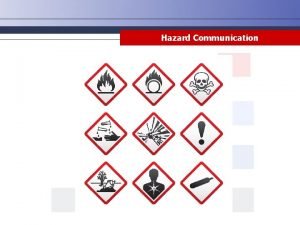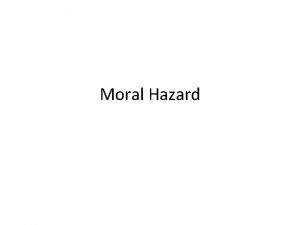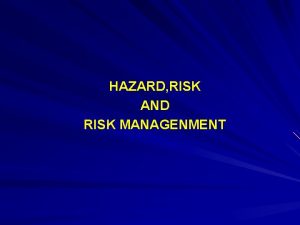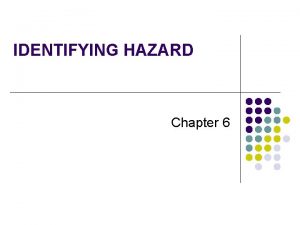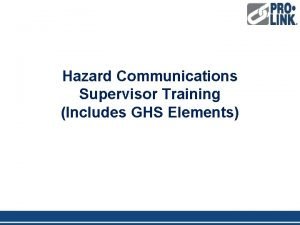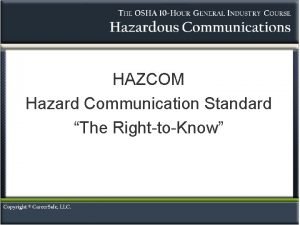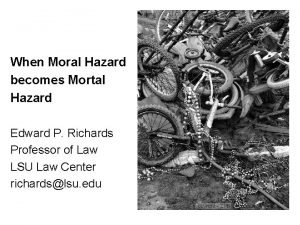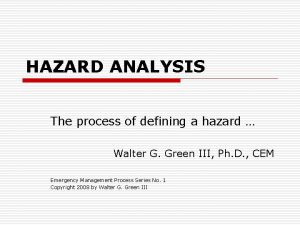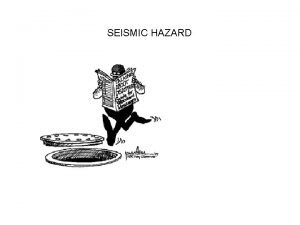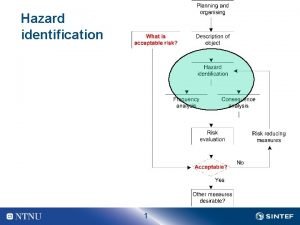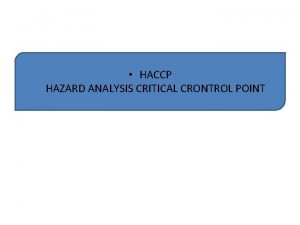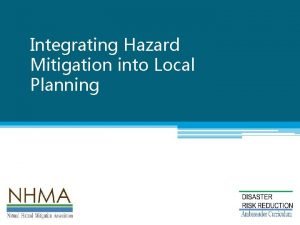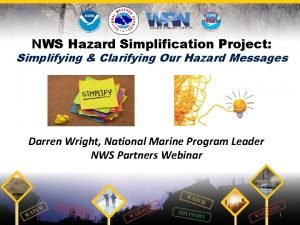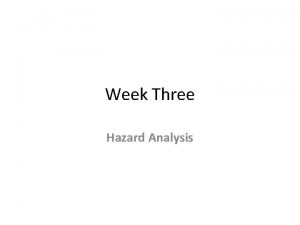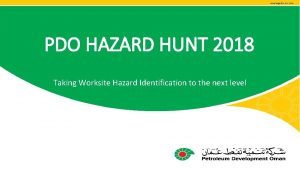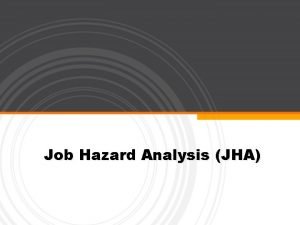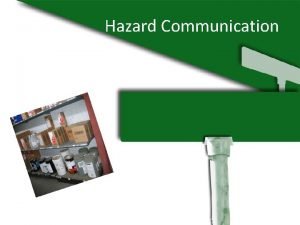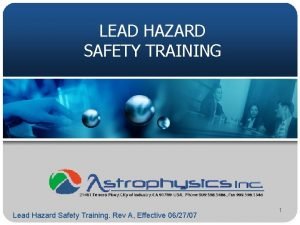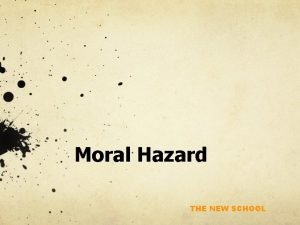What is a hazard A hazard is the










































- Slides: 42

What is a hazard? A hazard is the potential for harm. In practical terms, a hazard often is associated with a condition or activity that, if left uncontrolled, can result in an injury or illness. See Identifying hazards and eliminating or controlling them as early as possible will help prevent injuries and illnesses.

What is a job hazard analysis? A job hazard analysis is a technique that focuses on job tasks as a way to identify hazards before they occur. It focuses on the relationship between the worker, the task, the tools, and the work environment. Ideally, after you identify uncontrolled hazards, you will take steps to eliminate or reduce them to an acceptable risk level.

Why is job hazard analysis important? Many workers are injured and killed at the workplace every day. Safety and health can add value to your business, your job, and your life. You can help prevent workplace injuries and illnesses by looking at your workplace operations, establishing proper job procedures, and ensuring that all employees are trained properly. One of the best ways to determine and establish proper work procedures is to conduct a job hazard analysis. A job hazard analysis is one component of the larger commitment of a safety and health management system.

What is the value of a job hazard analysis? Supervisors can use the findings of a job hazard analysis to eliminate and prevent hazards in their workplaces. This is likely to result in fewer worker injuries and illnesses; safer, more effective work methods; reduced workers’ compensation costs; and increased worker productivity. The analysis also can be a valuable tool for training new employees in the steps required to perform their jobs safely. For a job hazard analysis to be effective, management must demonstrate its commitment to safety and health and follow through to correct any uncontrolled hazards identified. Otherwise, management will lose credibility and employees may hesitate to go to management when dangerous conditions threaten them.

What jobs are appropriate for a job hazard analysis? A job hazard analysis can be conducted on many jobs in your workplace. Priority should go to the following types of jobs: • Jobs with the highest injury or illness rates; • Jobs with the potential to cause severe or disabling injuries or illness, even if there is no history of previous accidents; • Jobs in which one simple human error could lead to a severe accident or injury; • Jobs that are new to your operation or have undergone

Where do I begin? 1. Involve your employees. It is very important to involve your employees in the hazard analysis process. They have a unique understanding of the job, and this knowledge is invaluable for finding hazards. Involving employees will help minimize oversights, ensure a quality analysis, and get workers to “buy in” to the solutions because they will share ownership in their safety and health program.

2. Review your accident history. Review with your employees your worksite’s history of accidents and occupational illnesses that needed treatment, losses that required repair or replacement, and any “near misses” —events in which an accident or loss did not occur, but could have. These events are indicators that the existing hazard controls (if any) may not be adequate and deserve more scrutiny.

3. Conduct a preliminary job review. Discuss with your employees the hazards they know exist in their current work and surroundings. Brainstorm with them For ideas to eliminate or control those hazards

If any hazards exist that pose an immediate danger to an employee’s life or health, take immediate action to protect the worker. Any problems that can be corrected easily should be corrected as soon as possible. Do not wait to complete your job hazard analysis. This will demonstrate your commitment to safety and health and enable you to focus on the hazards and jobs that need more study because of their complexity.

4. List, rank, and set priorities for hazardous jobs. List jobs with hazards that present unacceptable risks, based on those most likely to occur and with the most severe consequences. These jobs should be your first priority for analysis

5. Outline the steps or tasks. Nearly every job can be broken down into job tasks or steps. When beginning a job hazard analysis, watch the employee perform the job and list each step as the worker takes it. Be sure to record enough information to describe each job action without getting overly detailed. Avoid making the breakdown of steps so detailed that it becomes unnecessarily long or so broad that it does not include basic steps

You may find it valuable to get input from other workers who have performed the same job. Later, review the job steps with the employee to make sure you have not omitted something. Point out that you are evaluating the job itself, not the employee’s job performance. Include the employee in all phases of the analysis—from reviewing the job steps and procedures to discussing uncontrolled hazards and recommended solutions.

Sometimes, in conducting a job hazard analysis, it may be helpful to photograph or videotape the worker performing the job. These visual records can be handy references when doing a more detailed analysis of the work.

How do I identify workplace hazards? A job hazard analysis is an exercise in detective work. Your goal is to discover the following: • What can go wrong? • What are the consequences? • How could it arise? • What are other contributing factors? • How likely is it that the hazard will occur?

To make your job hazard analysis useful, document the answers to these questions in a consistent manner. Describing a hazard in this way helps to ensure that your efforts to eliminate the hazard and implement hazard controls help target the most important contributors to the hazard.

Good hazard scenarios describe: • Where it is happening (environment), • Who or what it is happening to (exposure), • What precipitates the hazard (trigger), • The outcome that would occur should it happen (consequence) • Any other contributing factors.

Rarely is a hazard a simple case of one singular cause resulting in one singular effect. More frequently, many contributing factors tend to line up in a certain way to create the hazard. Here is an example of a hazard scenario: In the metal shop (environment), while clearing a snag (trigger), a worker’s hand (exposure) comes into contact with a rotating pulley. It pulls his hand into the machine and severs his fingers (consequences) quickly.

To perform a job hazard analysis, you would ask: • What can go wrong? The worker’s hand could come into contact with a rotating object that “catches” it and pulls it into the machine.

• What are the consequences? The worker could receive a severe injury and lose fingers and hands.

• How could it happen? The accident could happen as a result of the worker trying to clear a snag during operations or as part of a maintenance activity while the pulley is operating. Obviously, this hazard scenario could not occur if the pulley is not rotating.

• What are other contributing factors? This hazard occurs very quickly. It does not give the worker much opportunity to recover or prevent it once his hand comes into contact with the pulley. This is an important factor, because it helps you determine the severity and likelihood of an accident when selecting appropriate hazard controls. Unfortunately, experience has shown that training is not very effective in hazard control when triggering events happen quickly because humans can react only so quickly.

• How likely is it that the hazard will occur? This determination requires some judgment. If there have been “near-misses” or actual cases, then the likelihood of a recurrence would be considered high. If the pulley is exposed and easily accessible, that also is a consideration. In the example, the likelihood that the hazard will occur is high because there is no guard preventing contact, and the operation is performed while the machine is running. By following the steps in this example, you can organize your hazard analysis activities.

Example Job Hazard Analysis Form Job Location: Analyst: Date: Metal Shop Job Safety Task Description: Worker reaches into metal box to the right of the machine, grasps a 15 -pound casting and carries it to grinding wheel. Worker grinds 20 to 30 castings per hour. Hazard Description: Picking up a casting, the employee could drop it onto his foot. The casting’s weight and height could seriously injure the worker’s foot or toes. Hazard Controls: 1. Remove castings from the box and place them on a table next to the grinder. 2. Wear steel-toe shoes with arch protection. 3. Change protective gloves that allow a better grip. 4. Use a device to pick up castings.

Job Location: Metal Shop Task Description: Worker reaches into metal box to the right of the machine, grasps a 15 -pound casting and carries it to grinding wheel. Worker grinds 20 to 30 castings per hour. Hazard Description: Castings have sharp burrs and edges that can cause severe lacerations. Hazard Controls: 1. Use a device such as a clamp to pick up castings. 2. Wear cut-resistant gloves that allow a good grip and fit tightly to minimize the chance that they will get caught in grinding wheel.

Location: Metal Shop Task Description: Worker reaches into metal box to the right of the machine, grasps a 15 -pound casting and carries it to grinding wheel. Worker grinds 20 to 30 castings per hour. Hazard Description: Reaching, twisting, and lifting 15 -pound castings from the floor could result in a muscle strain to the lower back. Hazard Controls: 1. Move castings from the ground and place them closer to the work zone to minimize lifting. Ideally, place them at waist height or on an adjustable platform or pallet. 2. Train workers not to twist while lifting and reconfigure work stations to minimize twisting during lifts.

How do I correct or prevent hazards? After reviewing your list of hazards with the employee, consider what control methods will eliminate or reduce them. The most effective controls are engineering controls that physically change a machine or work environment to prevent employee exposure to the hazard. The more reliable or less likely a hazard control can be circumvented, the better. If this is not feasible, administrative controls may be appropriate. This may involve changing how employees do their jobs. Discuss your recommendations with all employees who perform the job and consider their responses carefully. If you plan to introduce new or modified job procedures, be sure they understand what they are required to do and the reasons for the changes.

What else do I need to know before starting a job hazard analysis? The job procedures discussed in this booklet are for illustration only and do not necessarily include all the steps, hazards, and protections that apply to your industry. When conducting your own job safety analysis, be sure to consult the Occupational Safety and Health Administration standards for your industry. Compliance with these standards is mandatory, and by incorporating their requirements in your job hazard analysis, you can be sure that your health and safety program meets federal standards. OSHA standards, regulations, and technical information are available online at www. osha. gov.

Why should I review my job hazard analysis? Periodically reviewing your job hazard analysis ensures that it remains current and continues to help reduce workplace accidents and injuries. Even if the job has not changed, it is possible that during the review process you will identify hazards that were not identified in the initial analysis.

It is particularly important to review your job hazard analysis if an illness or injury occurs on a specific job. Based on the circumstances, you may determine that you need to change the job procedure to prevent similar incidents in the future. If an employee’s failure to follow proper job procedures results in a “close call, ” discuss the situation with all employees who perform the job and remind them of proper procedures. Any time you revise a job hazard analysis, it is important to train all employees affected by the changes in the new job methods, procedures…

When is it appropriate to hire a professional to conduct a job hazard analysis? If your employees are involved in many different or complex processes, you need professional help conducting your job hazard analyses. Sources of help include your insurance company, the local fire department, and private consultants with safety and health expertise. In addition, OSHA offers assistance through its regional and area offices and consultation services. Contact numbers are listed at the back of this publication.

Even when you receive outside help, it is important that you and your employees remain involved in the process of identifying and correcting hazards because you are on the worksite every day and most likely to encounter these hazards. New circumstances and a recombination of existing circumstances may cause old hazards to reappear and new hazards to appear. In addition, you and your employees must be ready and able to implement whatever hazard elimination or control measures a professional consultant recommends.

Hazard Control Measures Information obtained from a job hazard analysis is useless unless hazard control measures recommended in the analysis are incorporated into the tasks. Managers should recognize that not all hazard controls are equal. Some are more effective than others at reducing the risk. The order of precedence and effectiveness of hazard control is the following: 1. Engineering controls. 2. Administrative controls. 3. Personal protective equipment

Engineering controls include the following: • Elimination/minimization of the hazard—Designing the facility, equipment, or process to remove the hazard, or substituting processes, equipment, materials, or other factors to lessen the hazard; • Enclosure of the hazard using enclosed cabs, enclosures for noisy equipment, or other means; • Isolation of the hazard with interlocks, machine guards, blast shields, welding curtains, or other means; and • Removal or redirection of the hazard such as with local and exhaust ventilation

Administrative controls include the following: • Written operating procedures, work permits, and safe work practices; • Exposure time limitations (used most commonly to control temperature extremes and ergonomic hazards); • Monitoring the use of highly hazardous materials; • Alarms, signs, and warnings; • Buddy system; and • Training.

Personal Protective Equipment —such as respirators, hearing protection, protective clothing, safety glasses, and hardhats—is acceptable as a control method in the following circumstances: • When engineering controls are not feasible or do not totally eliminate the hazard; • While engineering controls are being developed; • When safe work practices do not provide sufficient additional protection; and • During emergencies when engineering controls may not be feasible

Use of one hazard control method over another higher in the control precedence may be appropriate for providing in term protection until the hazard is abated permanently. In reality, if the hazard cannot be eliminated entirely, the adopted control measures will likely be a combination of all three items instituted simultaneously.






 Bổ thể
Bổ thể Từ ngữ thể hiện lòng nhân hậu
Từ ngữ thể hiện lòng nhân hậu Tư thế ngồi viết
Tư thế ngồi viết Ví dụ giọng cùng tên
Ví dụ giọng cùng tên Thơ thất ngôn tứ tuyệt đường luật
Thơ thất ngôn tứ tuyệt đường luật Phép trừ bù
Phép trừ bù Alleluia hat len nguoi oi
Alleluia hat len nguoi oi Sự nuôi và dạy con của hươu
Sự nuôi và dạy con của hươu Diễn thế sinh thái là
Diễn thế sinh thái là đại từ thay thế
đại từ thay thế Vẽ hình chiếu vuông góc của vật thể sau
Vẽ hình chiếu vuông góc của vật thể sau Công thức tính thế năng
Công thức tính thế năng Tỉ lệ cơ thể trẻ em
Tỉ lệ cơ thể trẻ em Thế nào là mạng điện lắp đặt kiểu nổi
Thế nào là mạng điện lắp đặt kiểu nổi Lời thề hippocrates
Lời thề hippocrates Vẽ hình chiếu đứng bằng cạnh của vật thể
Vẽ hình chiếu đứng bằng cạnh của vật thể độ dài liên kết
độ dài liên kết Quá trình desamine hóa có thể tạo ra
Quá trình desamine hóa có thể tạo ra Môn thể thao bắt đầu bằng từ đua
Môn thể thao bắt đầu bằng từ đua Hình ảnh bộ gõ cơ thể búng tay
Hình ảnh bộ gõ cơ thể búng tay Sự nuôi và dạy con của hổ
Sự nuôi và dạy con của hổ điện thế nghỉ
điện thế nghỉ Các loại đột biến cấu trúc nhiễm sắc thể
Các loại đột biến cấu trúc nhiễm sắc thể Biện pháp chống mỏi cơ
Biện pháp chống mỏi cơ Trời xanh đây là của chúng ta thể thơ
Trời xanh đây là của chúng ta thể thơ Gấu đi như thế nào
Gấu đi như thế nào Thiếu nhi thế giới liên hoan
Thiếu nhi thế giới liên hoan Tia chieu sa te
Tia chieu sa te Một số thể thơ truyền thống
Một số thể thơ truyền thống Thế nào là hệ số cao nhất
Thế nào là hệ số cao nhất Sơ đồ cơ thể người
Sơ đồ cơ thể người Tư thế ngồi viết
Tư thế ngồi viết Số nguyên tố là gì
Số nguyên tố là gì đặc điểm cơ thể của người tối cổ
đặc điểm cơ thể của người tối cổ Các châu lục và đại dương trên thế giới
Các châu lục và đại dương trên thế giới Mật thư tọa độ 5x5
Mật thư tọa độ 5x5 Glasgow thang điểm
Glasgow thang điểm ưu thế lai là gì
ưu thế lai là gì Thẻ vin
Thẻ vin Cái miệng bé xinh thế chỉ nói điều hay thôi
Cái miệng bé xinh thế chỉ nói điều hay thôi Các châu lục và đại dương trên thế giới
Các châu lục và đại dương trên thế giới Hazard hunt game
Hazard hunt game










































